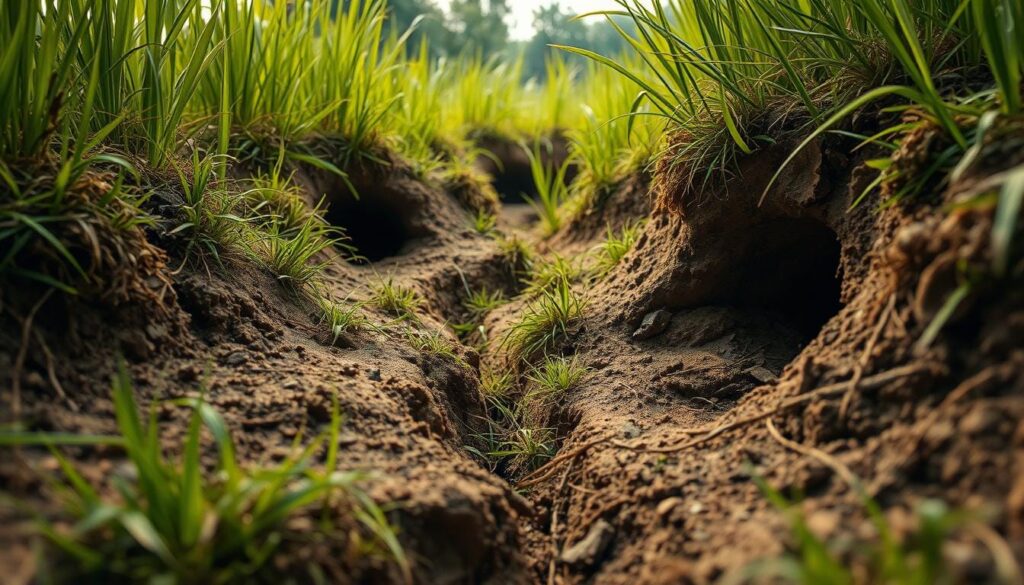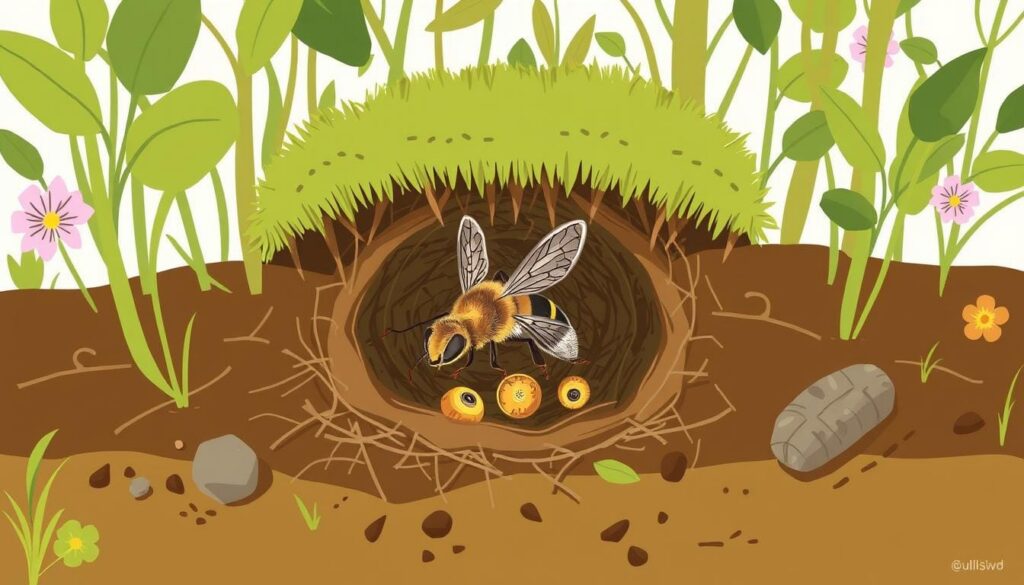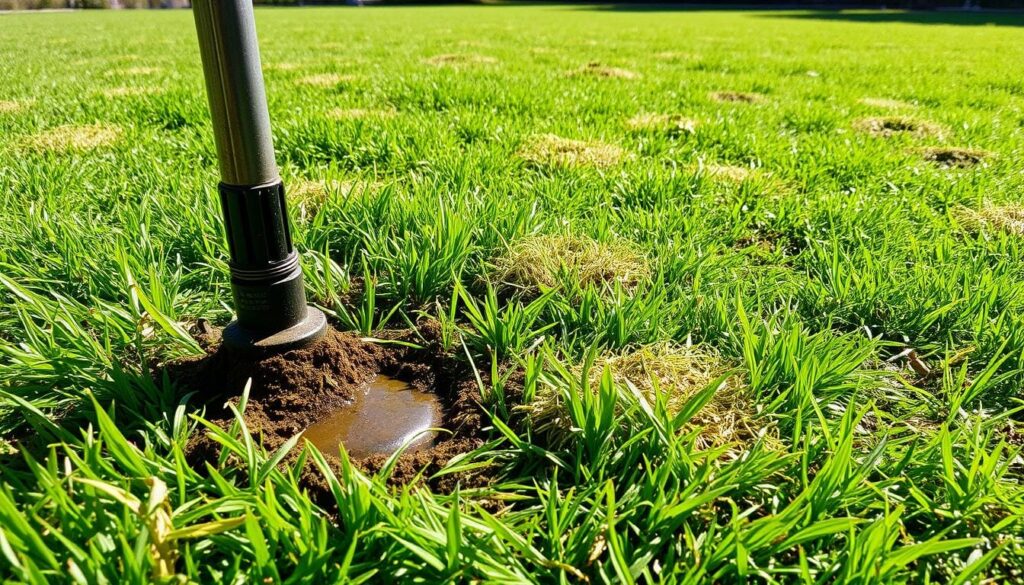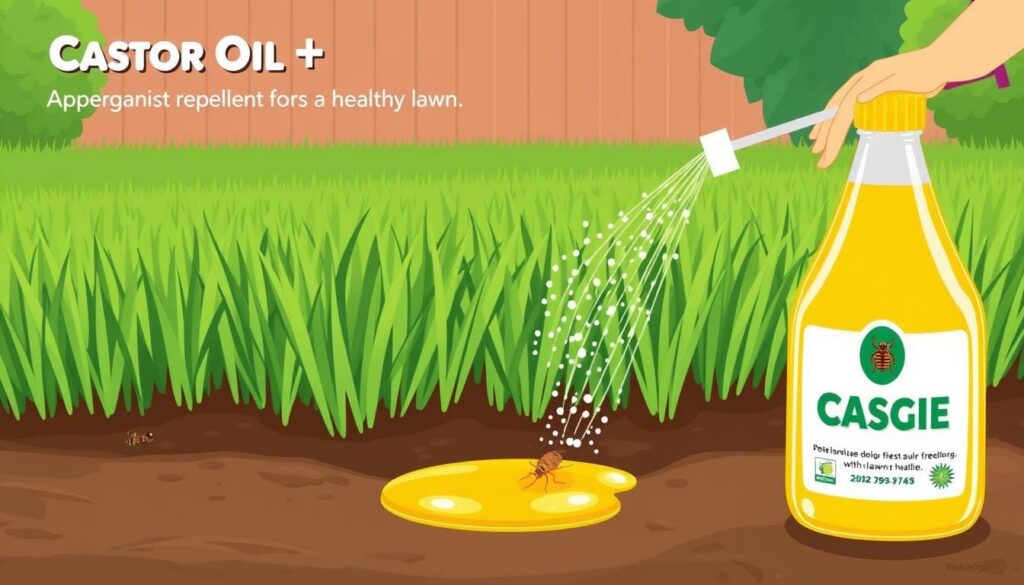Discovering small holes in your otherwise pristine lawn can be both frustrating and puzzling. These mysterious holes can appear overnight, leaving you wondering what’s causing them and how to fix them.
Before you can address the issue, it’s crucial to identify the culprit behind these unwanted lawn features. Often, they’re a sign of burrowing creatures like bees, worms, and voles making themselves at home in your soil. Understanding the cause is key to effective treatment and preventing future occurrences.
This comprehensive guide will walk you through the common causes of these holes and provide practical solutions to restore your lawn’s health and appearance, helping you regain control over your outdoor space.
Key Takeaways
- Identify the common causes of tiny holes in your yard.
- Learn how to distinguish between different types of burrowing creatures.
- Discover effective methods to control and prevent future holes.
- Understand the importance of soil health in preventing lawn damage.
- Implement targeted solutions to restore your lawn’s appearance.
Understanding Tiny Holes in Your Yard

The appearance of tiny holes in your yard can be both puzzling and concerning. These holes can be a sign of an underlying issue that needs to be addressed. Properly identifying the cause of these holes is essential for effective treatment and long-term lawn health.
Different creatures can create distinctive hole patterns, sizes, and surrounding evidence that can help you determine what’s causing the damage to your lawn. For instance, various animals and insects can be responsible for the holes you see.
Why Identifying the Cause Matters
Identifying the cause of tiny holes in your yard is crucial because misidentifying the issue can lead to ineffective treatments, wasted resources, and potentially worsening the problem over time. Untreated holes can result in more serious lawn issues, including dead patches, soil erosion, and creating entry points for additional pests.
- Proper identification helps in applying targeted solutions, saving time and money.
- Different causes require different treatments, making accurate diagnosis key.
- Ignoring the issue can lead to further damage and more costly repairs.
Burrowing Animals: The Primary Culprits

The presence of small holes in your lawn can be attributed to various burrowing animals that tunnel beneath the surface. These animals can cause significant damage to your lawn if left unchecked.
Moles and Their Volcano-Shaped Mounds
Moles are common lawn pests that create distinctive volcano-shaped mounds and tunnel systems as they search for grubs and earthworms beneath your lawn. Their tunnels are about 2 inches wide, and the mounds are a clear indication of their activity.
Voles and Their Surface Runways
Voles create smaller burrow openings with clean edges and visible surface runways, often causing damage to grass roots that results in dead brown patches. Their burrows are typically 1 to 2 inches wide.
Chipmunks and Squirrels
Chipmunks and squirrels dig holes approximately 1-2 inches in diameter, often in search of places to store food or create nesting areas. These holes can be around the size of a silver dollar.
| Animal | Hole/Tunnel Size | Distinctive Features |
|---|---|---|
| Moles | 2 inches wide | Volcano-shaped mounds |
| Voles | 1-2 inches wide | Clean edges, surface runways |
| Chipmunks/Squirrels | 1-2 inches diameter | Clean holes, around silver dollar size |
Insect-Related Holes in Your Lawn
Several types of insects are known to create holes in lawns as part of their nesting behaviors. These insects can be beneficial or potentially hazardous, depending on their species and activities.
Ground-Nesting Bees and Wasps
Ground-nesting bees typically create small, perfectly circular holes about 1/4-inch in diameter, often appearing in clusters across dry, sparse areas of the lawn. These bees are generally solitary and non-aggressive.

Cicada Killer Wasps
Cicada killer wasps dig larger tunnels, approximately 1/2-inch wide, creating small mounds of loose soil at the entrance where they drag paralyzed cicadas inside as food for their larvae.
Yellowjacket Wasp Nests
Yellowjacket wasps create underground nests with multiple entrance holes, posing potential safety hazards due to their aggressive defensive behavior when threatened.
While some of these insects are beneficial pollinators or predators of garden pests, their nesting activities can create unsightly holes and potentially dangerous situations in residential lawns.
Crawfish and Earthworm Activity

The presence of tiny holes in your lawn can be attributed to various factors, including crawfish and earthworm activity. These creatures, while often having different impacts on your lawn, both contribute to the creation of small holes.
Identifying Crawfish Holes
Crawfish, also known as crayfish, are known to dig holes that are typically 2 inches wide and 6 to 12 inches deep. The excavated dirt forms a mound of mud around the hole, creating distinctive mud chimneys or towers. These are usually found in areas with high soil moisture or near water sources.
Earthworm Castings and Their Impact
Earthworms, on the other hand, leave small piles of dirt around 1/4 to 1/2 inch holes as they push castings up while feeding. This activity disrupts grass growth but improves overall soil health. Earthworm activity is more pronounced in spring and fall when soil conditions are moist and temperatures are moderate, leading to more visible castings during these seasons.
Grubs and Secondary Damage
Tiny holes in your yard can be a sign of a more significant issue, such as grub infestation and subsequent animal digging. Grubs, the larval stage of various beetles, feed on grass roots beneath the soil surface, causing significant damage to your lawn.
How Grubs Affect Your Lawn
Grubs weaken and damage turf by consuming grass roots, leading to patches of wilting, brown grass that can be easily pulled up. Heavy grub infestations can cause extensive root damage, making your lawn more susceptible to drought stress and creating ideal conditions for weed invasion. Effective grub control is crucial to maintaining a healthy lawn.
Animals That Dig for Grubs
While grubs themselves don’t create visible holes, they attract predators like skunks, raccoons, and birds that dig into the lawn searching for these protein-rich snacks. The secondary damage from animals digging for grubs often appears as scattered, shallow holes or torn-up patches of turf across affected areas of the lawn.
| Animal | Damage Description |
|---|---|
| Skunks | Dig small, shallow holes |
| Raccoons | Tear up turf in search of grubs |
| Birds | Pull up grass, creating patches |
Weather and Irrigation Causes

Weather extremes and irrigation issues can significantly impact the integrity of your lawn. The combination of heavy rainfall, freezing temperatures, and irrigation system malfunctions can lead to the formation of tiny holes in your yard.
These issues can cause significant damage to your turf over time if left unaddressed.
Erosion and Water Damage
Heavy rainfall can lead to erosion, washing away soil particles and creating small depressions that eventually develop into more noticeable holes. Areas with poor drainage are particularly susceptible to this type of damage.
| Cause | Effect |
|---|---|
| Heavy Rainfall | Erosion and Soil Displacement |
| Poor Drainage | Water Accumulation and Hole Formation |
Irrigation System Leaks
Irrigation system leaks can also contribute to the formation of holes in your lawn. When water leaks from compromised irrigation lines, it can erode the surrounding soil, creating sunken areas that become more pronounced over time.
Effective Solutions for Tiny Holes in Yard
A lawn dotted with tiny holes can be a nuisance, but with the right approach, you can repair the damage and prevent future occurrences.

Filling and Repairing Holes Properly
To repair holes effectively, start by flattening any raised soil or mounds using a lawn roller or by leveling with a rake. For deep depressions, applying a layer of quality topsoil can help fill them.
For small holes, a mixture of topsoil, compost, and sand can be used to fill the depressions. It’s essential to tamp down gently to ensure the fill material is firm but not compacted.
Soil Amendments and Grass Seed
Once the holes are filled, reseed bare areas with a premium grass seed to encourage new grass growth and deter weeds. Choose a grass variety that matches your existing lawn to promote uniform growth and appearance.
Maintaining proper soil moisture after repairs is crucial to help new grass establish quickly and prevent the filled areas from settling or washing away.
When to Use Traps vs. Repellents
When dealing with animal-caused holes in your lawn, consider whether traps or repellents are more appropriate based on the specific animal and the extent of the damage. Understanding the cause is key to choosing the right solution.
For a single hole or minor damage, repellents might be sufficient. However, for extensive damage or recurring issues, traps might be necessary to control the problem effectively.
After filling the holes, overseeding the area can help restore the lawn‘s surface to its original state.
Natural and Chemical Control Methods
To address tiny holes in your yard, it’s essential to consider both natural and chemical control methods. These approaches can help manage lawn pests effectively, ensuring your yard remains healthy and visually appealing.
Castor Oil and Other Natural Repellents

Natural repellents like castor oil can effectively deter burrowing animals such as moles and voles without causing harm to your lawn or the environment. A spray of castor oil can temporarily repel these pests for about two weeks by saturating the affected area.
Beneficial Nematodes for Grub Control
Beneficial nematodes offer a biological control method for grubs, parasitizing and killing the larvae. This method is safe for humans, pets, and beneficial insects, making it an environmentally friendly option for pest control.
Chemical Options and Their Effectiveness
While chemical insecticides can provide effective control for certain lawn pests, they should be used judiciously and according to label instructions to minimize environmental impact. It’s crucial to consider the potential effects on beneficial organisms like earthworms and pollinators when selecting control methods.
Combining multiple control methods often provides the most sustainable and effective long-term solutions for managing lawn pests. Whether opting for natural repellents, biological controls, or chemical treatments, a thoughtful approach to pest control is essential for maintaining a healthy lawn.
Prevention Strategies for a Hole-Free Lawn
Preventing tiny holes in your yard involves a multi-faceted approach that includes regular lawn maintenance and creating an unwelcoming environment for pests. By adopting these strategies, you can significantly reduce the occurrence of tiny holes and maintain a healthy, visually appealing lawn.
Seasonal Lawn Maintenance Tips
Regular lawn maintenance is crucial for preventing tiny holes. This includes mowing your grass to a height of 3 to 3.5 inches, which promotes deeper root growth and makes your lawn less hospitable to pests. Additionally, annual core aeration helps reduce soil compaction and thatch buildup, improving water penetration and root development.
| Maintenance Task | Frequency | Benefit |
|---|---|---|
| Mowing | Weekly during growing season | Promotes healthy grass growth |
| Fertilization | As needed, based on soil test | Provides essential nutrients for grass |
| Aeration | Annually | Reduces soil compaction and thatch |
Creating an Unwelcoming Environment for Pests
Removing potential food sources is a critical step in discouraging wildlife from visiting your yard. This includes removing bird feeders, pet food, and fallen fruit from trees. By eliminating these attractants, you can make your yard less appealing to pests that might create holes.
When to Call a Professional
Severe pest infestations often necessitate the intervention of a professional pest control service. These infestations can lead to significant damage to your lawn and potentially pose safety risks to your family and pets.
Identifying when to seek professional help is crucial. If you notice large infestations, dangerous pests like yellowjackets, or if DIY methods have failed to resolve the issue, it’s time to call in the experts. Professionals have the necessary equipment, training, and experience to handle complex pest control situations effectively and safely.
- Professional intervention is necessary for large infestations or when dealing with dangerous pests.
- Licensed pest control professionals have access to specialized equipment and techniques.
- Wildlife removal specialists are required for larger animals causing damage.
- Professional lawn care services can address both the immediate hole problems and underlying lawn health issues.
- The cost of professional services should be weighed against potential property damage and safety concerns.
A professional can diagnose mysterious damage, identify the root cause of the holes in your lawn, and develop a customized treatment plan. This not only fixes the immediate problem but also helps prevent future occurrences.
| Situation | DIY Solution | Professional Solution |
|---|---|---|
| Large Infestations | Limited effectiveness, potential for increased risk | Effective treatment, safe handling of pests |
| Dangerous Pests (e.g., Yellowjackets) | High risk of injury, potential for nest relocation | Safe removal, prevention of future nests |
| Mysterious Lawn Damage | Difficulty in diagnosis, potential for misidentification | Accurate diagnosis, targeted treatment plan |
As emphasized by pest control experts, “The key to effective pest control is not just eliminating the current problem but also preventing future infestations.” This approach ensures a healthier and safer lawn for you and your family.
Conclusion
Tiny holes in your yard can be a sign of underlying issues that need to be addressed. Unaddressed holes can lead to dead grass, erosion, and unsightliness, making regular lawn inspection crucial. By understanding the causes, which can range from burrowing animals to insect activity and environmental factors, you can take targeted action. For more information on lawn care and maintenance, visit this resource. With the right approach, you can restore your lawn’s health and appearance, preventing future hole problems.

